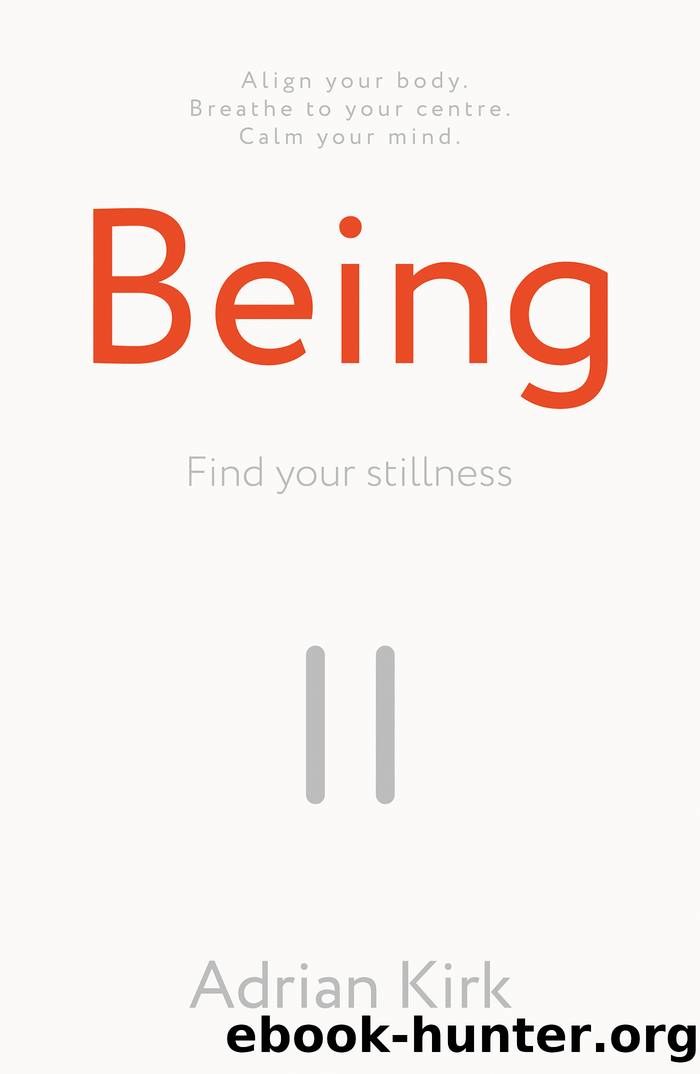Being by Adrian Kirk

Author:Adrian Kirk
Language: eng
Format: epub
Publisher: Troubador Publishing Ltd
Published: 2021-08-10T00:00:00+00:00
Doing the exercise once may be enough for you to now recognise where and when you have tension and be able to let it go. I first encountered the exercise when at drama school in the late 1990âs and it has stayed with me ever since. You may want to do it several times, or re-visit it every now and then; itâs certainly a good way to learn more about your body and help maintain a relaxed physical state.
Up-right
Now that youâre aware of tension creeping in to your body and are moving towards being able to let it go, itâs time to re-familiarise with your bodyâs wonderful design. Weâve already covered this in the Physical chapter, but for the sake of sequential flow, here it is again.
Just as youâll benefit from doing the tension-relaxation exercise a few times, youâll also benefit from working on physical alignment until you are familiar with what you have available at any moment: the superbly engineered, refined instrument that is your body. Initially, Iâd like you to do this exercise standing as it helps you connect with your piece of earth and give you a right to be in your own space. However, once you are familiar with it youâll be able to practise it anywhere: standing, sitting, walking or lying; in your car, in the gym, at work, at the supermarket. This body is wonderful; learn to connect with it and use it more efficiently. It is, after all, always with you.
Exercise:
1.Assume the hip width apart standing position, feeling gravityâs downward energy connecting you to your piece of earth.
2.Collapse your spine so you stoop: your back curving forward, head drooping toward chest and arms hanging loose as they dangle; let what is above the belt feel floppy and loose. Notice the general concave nature of your chest area, as if it has retreated with the shoulders coming round to protect your chest and centre.
3.Stay in the position for around ten seconds.
4.Notice how you may feel it harder to breathe; the neck may also feel constrained and the throat tight.
5.Now, imagine energy coming up the spine and allow yourself to lift, slowly. A good way to do this is to visualise each vertebra rising to sit slowly on top of the one beneath. Start with the vertebrae in your lower back, pretty much where you belly button would be at the front; when one vertebra is aligned let the next slowly rise to sit on top, then the next and the next. Importantly, do not move anything but your spine, one vertebra at a time; let shoulders, arms and chest simply fall into position as you rise. When the time is right, the head will sit on top of the last vertebra. Some useful tips:
oEnsure your knees donât become locked tight as you rise up; keep your knees âoff lockâ.
oLet your shoulders fall in to place before allowing the head to fully come in line on top.
oAvoid introducing tension in the muscles around the spine; you do not need to hold yourself tight.
Download
This site does not store any files on its server. We only index and link to content provided by other sites. Please contact the content providers to delete copyright contents if any and email us, we'll remove relevant links or contents immediately.
Harry Potter and the Goblet Of Fire by J.K. Rowling(3026)
Unfinished: A Memoir by Priyanka Chopra Jonas(2912)
Never by Ken Follett(2873)
The Man Who Died Twice by Richard Osman(2291)
Machine Learning at Scale with H2O by Gregory Keys | David Whiting(2269)
Fairy Tale by Stephen King(2059)
Will by Will Smith(2033)
Rationality by Steven Pinker(1761)
The Storyteller by Dave Grohl(1656)
The Dawn of Everything: A New History of Humanity by David Graeber & David Wengrow(1565)
The Dark Hours by Michael Connelly(1563)
The Stranger in the Lifeboat by Mitch Albom(1529)
Cloud Cuckoo Land by Anthony Doerr(1428)
The Becoming by Nora Roberts(1324)
Friends, Lovers, and the Big Terrible Thing by Matthew Perry(1324)
Einstein: His Life and Universe by Walter Isaacson(1312)
Crying in H Mart by Michelle Zauner(1312)
New Morning Mercies: A Daily Gospel Devotional by Paul David Tripp(1305)
A Short History of War by Jeremy Black(1295)
